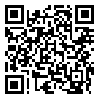Tue, Jul 1, 2025
| فارسی
Volume 26, Issue 4 (Winter 2021)
IJPCP 2021, 26(4): 490-501 |
Back to browse issues page
Download citation:
BibTeX | RIS | EndNote | Medlars | ProCite | Reference Manager | RefWorks
Send citation to:



BibTeX | RIS | EndNote | Medlars | ProCite | Reference Manager | RefWorks
Send citation to:
Zarei M, Nilipour R, Shati M, Shakeri S, Arezoomandan R, Amirzadeh K et al . Assessment of Aphasia in Iranian Patients Suffering from Frontotemporal Dementia. IJPCP 2021; 26 (4) :490-501
URL: http://ijpcp.iums.ac.ir/article-1-3094-en.html
URL: http://ijpcp.iums.ac.ir/article-1-3094-en.html
Mahsa Zarei1 

 , Reza Nilipour2
, Reza Nilipour2 

 , Mohsen Shati3
, Mohsen Shati3 

 , Shohreh Shakeri4
, Shohreh Shakeri4 

 , Reza Arezoomandan5
, Reza Arezoomandan5 

 , Kimia Amirzadeh6
, Kimia Amirzadeh6 

 , Fahimeh Hajiakhoundi7
, Fahimeh Hajiakhoundi7 




 , Reza Nilipour2
, Reza Nilipour2 

 , Mohsen Shati3
, Mohsen Shati3 

 , Shohreh Shakeri4
, Shohreh Shakeri4 

 , Reza Arezoomandan5
, Reza Arezoomandan5 

 , Kimia Amirzadeh6
, Kimia Amirzadeh6 

 , Fahimeh Hajiakhoundi7
, Fahimeh Hajiakhoundi7 


1- Department of Gerontology, School of Behavioral Science and Mental Health (Tehran Institute of Psychiatry), Iran University of Medical Sciences, Tehran, Iran. , mahsa.zareii@gmail.com
2- Department of Speech Therapy, University of Social Welfare And Rehabilitation Sciences, Tehran, Iran.
3- Department of Epidemiology, School of Behavioral Science and Mental Health (Tehran Institute of Psychiatry), Iran University of Medical Sciences, Tehran, Iran.
4- Department of Speech Therapy, Rasoole Akram Hospital, Iran University of Medical Sciences, Tehran, Iran.
5- Department of Addiction, School of Behavioral Science and Mental Health (Tehran Institute of Psychiatry), Iran University of Medical Sciences, Tehran, Iran.
6- Faculty of Dental, Shahed University, Tehran, Iran.
7- Department of Neurology, School of Medicine, Iran University of Medical Sciences, Tehran, Iran.
2- Department of Speech Therapy, University of Social Welfare And Rehabilitation Sciences, Tehran, Iran.
3- Department of Epidemiology, School of Behavioral Science and Mental Health (Tehran Institute of Psychiatry), Iran University of Medical Sciences, Tehran, Iran.
4- Department of Speech Therapy, Rasoole Akram Hospital, Iran University of Medical Sciences, Tehran, Iran.
5- Department of Addiction, School of Behavioral Science and Mental Health (Tehran Institute of Psychiatry), Iran University of Medical Sciences, Tehran, Iran.
6- Faculty of Dental, Shahed University, Tehran, Iran.
7- Department of Neurology, School of Medicine, Iran University of Medical Sciences, Tehran, Iran.
Abstract: (3462 Views)
Objectives: Frontotemporal Dementia (FTD) is an uncommon type of dementia. The hallmark feature of FTD is the presentation with aphasia or behavioral changes which vary in different FTD subtypes. In this study, we propose a quantitative aphasia test as an additive diagnostic tool for differentiation of FTD subtypes.
Methods: The applied study was conducted on 20 patients with FTD (13 men and 7 women) aged 58-78 years (Mean age=63±0.8 years) referred to dementia clinic of Rasul Akram Hospital in Tehran, Iran. Based on clinical diagnosis, patients were divided into three groups of behavioral variant (n=5), semantic dementia (n=4) and non-fluent aphasia (n=11). The Persian Western Aphasia Battery (P-WAB-1) test was performed on the patients to assess their aphasia severity based on its overall score (Aphasia Quotient). The score of each language section of the test was also reported for each study group, separately. After recording data, they were analyzed in SPSS v. 22 software using the whole rock analysis. Significance level of Aphasia Quotient score was measured separately for each study groups.
Results: Patients with non-fluent aphasia had problems only in the speech fluency domain, and their abilities in other domains remained intact.
Conclusion: It seems that P-WAB-1 test is a useful tool for assessing the non-fluent aphasia in patients who suffer from progressive dementia. These patients should be referred to speech therapist for rehabilitation.
Methods: The applied study was conducted on 20 patients with FTD (13 men and 7 women) aged 58-78 years (Mean age=63±0.8 years) referred to dementia clinic of Rasul Akram Hospital in Tehran, Iran. Based on clinical diagnosis, patients were divided into three groups of behavioral variant (n=5), semantic dementia (n=4) and non-fluent aphasia (n=11). The Persian Western Aphasia Battery (P-WAB-1) test was performed on the patients to assess their aphasia severity based on its overall score (Aphasia Quotient). The score of each language section of the test was also reported for each study group, separately. After recording data, they were analyzed in SPSS v. 22 software using the whole rock analysis. Significance level of Aphasia Quotient score was measured separately for each study groups.
Results: Patients with non-fluent aphasia had problems only in the speech fluency domain, and their abilities in other domains remained intact.
Conclusion: It seems that P-WAB-1 test is a useful tool for assessing the non-fluent aphasia in patients who suffer from progressive dementia. These patients should be referred to speech therapist for rehabilitation.
Type of Study: Original Research |
Subject:
Psychiatry and Psychology
Received: 2019/09/22 | Accepted: 2020/06/27 | Published: 2020/09/22
Received: 2019/09/22 | Accepted: 2020/06/27 | Published: 2020/09/22
| Rights and permissions | |
 |
This work is licensed under a Creative Commons Attribution-NonCommercial 4.0 International License. |



